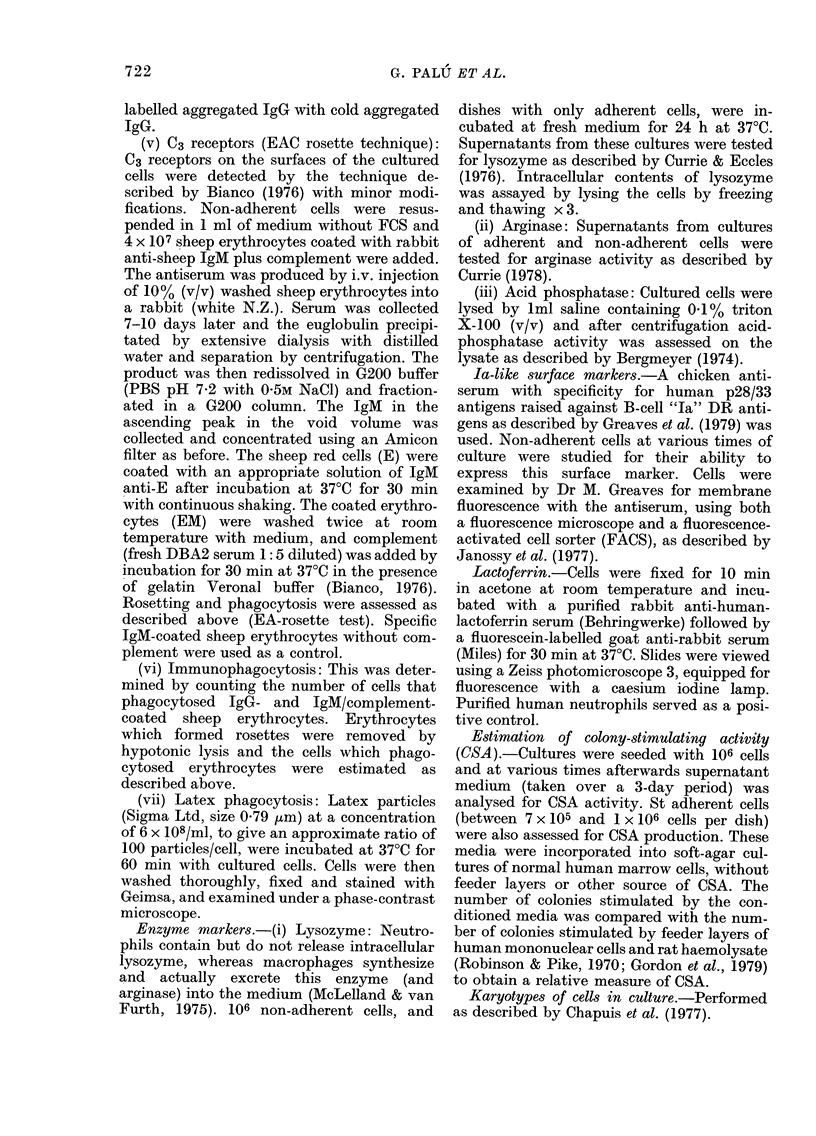Abstract
Leukaemic cells taken from the blood of patients with acute myelogenous leukaemia (AML) frequently proliferate in suspension culture without the addition of growth factors for a limited period only. After a 6--10-fold increase in total cells, cell numbers remain constant for a time and finally decline. The main cause for this limited growth in vitro is not, initially at least, cell death leading to a steady state, but maturation associated in its final stages with cessation of DNA synthesis. Two populations of AML cells from Patients St and Wi respectively were studied, and progressive maturation towards mature leucocytes was demonstrated by the gradual acquisition in culture by the growing blast cells of intracellular enzymes (lysozyme, arginase, acid phosphatase and esterase being measured), surface markers (Fc and C3 receptors), of lactoferrin by Wi cells and of colony-stimulating activity by St cells, as well as changes in Ia antigens, phagocytic properties, morphology and adhesiveness to plastic. With St cells, which carried a characteristic chromosome marker, maturation terminated in cells with the characteristic properties of macrophages. At an intermediate stage, non-adherent and still-dividing St cells acquired Fc and C3 receptors and enzymes characteristic of monocytes. Wi cells progressively became neutrophil-like, and again there was an intermediate population of dividing cells which had Fc and C3 receptors and proteins such as lactoferrin and esterases. characteristic of neutrophils.
Full text
PDF











Images in this article
Selected References
These references are in PubMed. This may not be the complete list of references from this article.
- Balkwill F. R., Oliver R. T. Diagnostic and prognostic significance of peripheral blood cultural characteristics in adult acute leukaemia. Br J Cancer. 1976 Apr;33(4):400–410. doi: 10.1038/bjc.1976.65. [DOI] [PMC free article] [PubMed] [Google Scholar]
- Chapuis B., Summersgill B. M., Cocks P., Howard P., Lawler S. D., Alexander P., Powles R. Test for cryopreservation efficiency of human acute myelogenous leukaemia cells relevant to clinical requirements. Cryobiology. 1977 Dec;14(6):637–648. doi: 10.1016/0011-2240(77)90018-9. [DOI] [PubMed] [Google Scholar]
- Collins S. J., Gallo R. C., Gallagher R. E. Continuous growth and differentiation of human myeloid leukaemic cells in suspension culture. Nature. 1977 Nov 24;270(5635):347–349. doi: 10.1038/270347a0. [DOI] [PubMed] [Google Scholar]
- Collins S. J., Ruscetti F. W., Gallagher R. E., Gallo R. C. Terminal differentiation of human promyelocytic leukemia cells induced by dimethyl sulfoxide and other polar compounds. Proc Natl Acad Sci U S A. 1978 May;75(5):2458–2462. doi: 10.1073/pnas.75.5.2458. [DOI] [PMC free article] [PubMed] [Google Scholar]
- Currie G. A. Activated macrophages kill tumour cells by releasing arginase. Nature. 1978 Jun 29;273(5665):758–759. doi: 10.1038/273758a0. [DOI] [PubMed] [Google Scholar]
- Currie G. A., Eccles S. A. Serum lysozyme as a marker of host resistance. I. Production by macrophages resident in rat sarcomata. Br J Cancer. 1976 Jan;33(1):51–59. doi: 10.1038/bjc.1976.6. [DOI] [PMC free article] [PubMed] [Google Scholar]
- Currie G. A., Hedley D. W. Monocytes and macrophages in malignant melanoma. I. Peripheral blood macrophage precursors. Br J Cancer. 1977 Jul;36(1):1–6. doi: 10.1038/bjc.1977.147. [DOI] [PMC free article] [PubMed] [Google Scholar]
- Fauerholdt L., Jacobsen N. Cultivation of leukemic human bone marrow cells in diffusion chambers implanted into normal and irradiated mice. Blood. 1975 Apr;45(4):495–501. [PubMed] [Google Scholar]
- Fibach E., Sachs L. Control of normal differentiation of myeloid leukemic cells. VIII. Induction of differentiation to mature granulocytes in mass culture. J Cell Physiol. 1975 Oct;86(2 Pt 1):221–230. doi: 10.1002/jcp.1040860205. [DOI] [PubMed] [Google Scholar]
- Hoelzer D., Kurrle E., Schmücker H., Harriss E. B. Evidence for differentiation of human leukemic blood cells in diffusion chamber culture. Blood. 1977 May;49(5):729–744. [PubMed] [Google Scholar]
- Honma Y., Kasukabe T., Hozumi M. Relationship between leukemogenicity and in vivo inducibility of normal differentiation in mouse myeloid leukemia cells. J Natl Cancer Inst. 1978 Sep;61(3):837–841. [PubMed] [Google Scholar]
- Ichikawa Y. Differentiation of a cell line of myeloid leukemia. J Cell Physiol. 1969 Dec;74(3):223–234. doi: 10.1002/jcp.1040740303. [DOI] [PubMed] [Google Scholar]
- KISSANE J. M., ROBINS E. The fluorometric measurement of deoxyribonucleic acid in animal tissues with special reference to the central nervous system. J Biol Chem. 1958 Jul;233(1):184–188. [PubMed] [Google Scholar]
- Kinkade J. M., Jr, Kellar K. L., Winton E. F. Immunochemical quantificaion of in vitro neutrophilic granulocyte differentiation. Nature. 1979 Jan 18;277(5693):225–227. doi: 10.1038/277225a0. [DOI] [PubMed] [Google Scholar]
- Li C. Y., Lam K. W., Yam L. T. Esterases in human leukocytes. J Histochem Cytochem. 1973 Jan;21(1):1–12. doi: 10.1177/21.1.1. [DOI] [PubMed] [Google Scholar]
- McClelland D. B., van Furth R. In vitro synthesis of lysozyme by human and mouse tissues and leucocytes. Immunology. 1975 Jun;28(6):1099–1114. [PMC free article] [PubMed] [Google Scholar]
- McConahey P. J., Dixon F. J. A method of trace iodination of proteins for immunologic studies. Int Arch Allergy Appl Immunol. 1966;29(2):185–189. doi: 10.1159/000229699. [DOI] [PubMed] [Google Scholar]
- Powles R. L., Lister T. A., Oliver R. T., Russell J., Smith C., Kay H. E., McElwain T. J., Fairley G. H. Safe method of collecting leukaemia cells from patients with acute leukaemia for use as immunotherapy. Br Med J. 1974 Nov 16;4(5941):375–379. doi: 10.1136/bmj.4.5941.375. [DOI] [PMC free article] [PubMed] [Google Scholar]
- Sachs L. The differentiation of myeloid leukaemia cells: new possibilities for therapy. Br J Haematol. 1978 Dec;40(4):509–517. doi: 10.1111/j.1365-2141.1978.tb05826.x. [DOI] [PubMed] [Google Scholar]
- Steele A. A., Sensenbrenner L. L., Young M. G. Growth and differentiation of normal and leukemic human bone marrow cells cultured in diffusion chambers. Exp Hematol. 1977 May;5(3):199–210. [PubMed] [Google Scholar]
- Winchester R. J., Ross G. D., Jarowski C. I., Wang C. Y., Halper J., Broxmeyer H. E. Expression of Ia-like antigen molecules on human granulocytes during early phases of differentiation. Proc Natl Acad Sci U S A. 1977 Sep;74(9):4012–4016. doi: 10.1073/pnas.74.9.4012. [DOI] [PMC free article] [PubMed] [Google Scholar]



